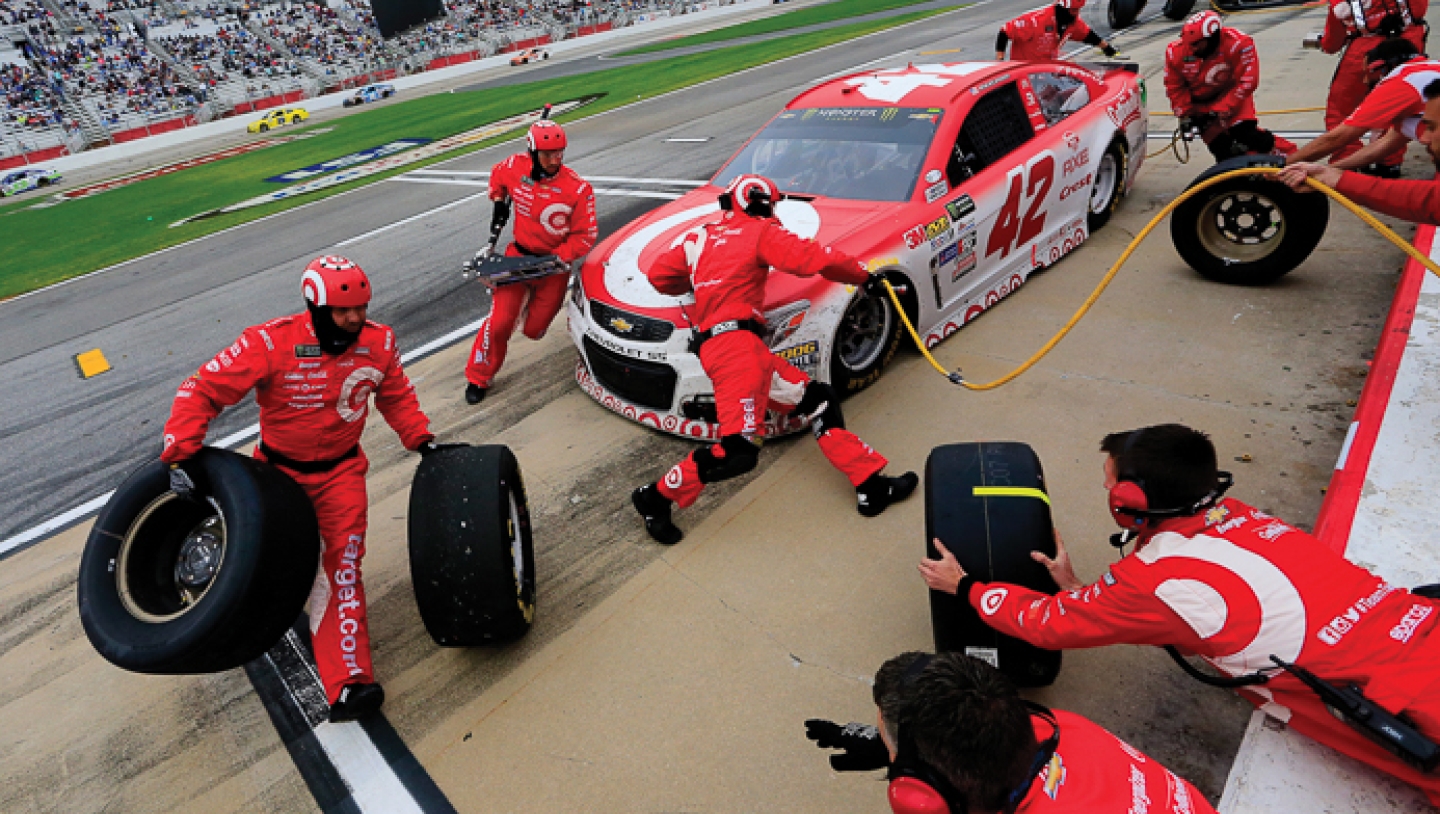Shaun Peet has one of the more unusual jobs in professional sports: He’s a pit road coach for a NASCAR team. He trains and prepares the six-man “over the wall” crews for Chip Ganassi Racing, which fields two cars at each of NASCAR’s top two levels.
Peet and fellow coach Mike Metcalf jokingly call themselves “the Department of Unrealistic Expectations,” as Peet puts it. “You’re asking us to change four tires and put two cans of gas in a car in 10 seconds, and you’re asking us to do it every single time,” he says. “We’re like, failure’s coming.”
Except it’s not. When Peet began his role in 2014, Ganassi’s two top-level cars in the NASCAR Cup Series ranked 22nd and 28th on pit road. In 2016, they ranked fourth and sixth. Fueled in part by lightning-quick stops, drivers Kyle Larson and Jamie McMurray are both having career seasons.
Peet played hockey at Dartmouth and joined a NASCAR pit road crew in the early 2000s after his minor-league career fizzled. That put him on the leading edge of a pit road revolution that saw greasy-fingered mechanics replaced by highly trained athletes. Virtually every man (and they are all men) who goes over the wall now has an extensive athletic background.
Only the biggest and most successful NASCAR teams, maybe six in all, have pit road coaches. The best pit crew members on the best teams earn up to mid-six figures in salary, all for “only” a handful of “plays” that, if they are successful, total in the neighborhood of one minute a week. Sounds easy, right? Not so much. Here, Peet, who was a jackman for 14 years, breaks down how his team changes four tires and puts two cans of gas in a car in 10 seconds (almost) every single time.
JACKMAN
All You Gotta Do: Use a jack to lift the car. Run around the car and repeat.
That’s Fast: The jackman carries a 35-pound jack that lifts a 3,500-pound car in one stroke. “We expect that done in less than 1.2 seconds from when the car stops,” says Peet. “From the time the car drops, until he runs around and gets the car up in the air, we expect that to be done in 3.8 seconds.”
What Could Go Wrong: The jackman is the most likely person on pit road to get hit. “You grow up and your parents say, ‘Don’t play in traffic.’ And now it’s how these guys make a living,” says Peet.
Physical/Mental Demands: He is the quarterback of the team and needs to be the strongest mentally. “If I have a guy who doesn’t have it together and he drops the car when the lug nuts aren’t installed, we have a problem,” Peet says.
TIRE CARRIERS
All You Gotta Do: Carry the new tires to the car and the old ones away from it.
That’s Fast: Each tire weighs 65 pounds and is carried at a dead sprint. Once the changer removes the tire, the carrier has .9 seconds to slam a new one into place.
What Could Go Wrong: “When the rear tire carrier is running around the car, he must avoid the gas man and whatever fuel the gas man has spilled. It’s like ice,” Peet says. And at the end of the pit stop, the front carrier sometimes puts on or removes tape to change the air flow to the car. The air flow partially determines how fast the car will run on subsequent laps. The margin of error in the placement of tape is 2 centimeters—if it’s misplaced, the car could overheat, or “blow up” in NASCAR parlance.
Physical/Mental Demands: Tire carriers need to be fast and agile, especially through the hips, as they carry 65-pound tires on a dead sprint with a sharp turn.
TIRE CHANGERS
All You Gotta Do: Unscrew five lug nuts and tighten five new lug nuts. Run around the car and do it again.
That’s Fast: From the time the car stops, the front tire changer has .2 seconds before he is expected to use his high-powered drill gun to hit the first lug nut. The rear tire changer has .9 seconds, the extra time allowed because the car is moving away from him. Each tire changer has one second to remove all five lug nuts. The pressure is huge, as two-tenths of a second can be up to 56 feet on the racetrack—the margin of victory is often less than that.
What Could Go Wrong: The front tire changer is in danger of being hit by the car, as he must run in front of it while it is moving 55 miles per hour. The rear changer isn’t in danger of being hit, but if the driver stops short, the rear changer could impale himself on the corner of the car.
Physical/Mental Demands: Tire changers need an explosive first step, hand-eye coordination and a low center of gravity—“They’re very much like a middle infielder on a baseball team,” Peet says.
GAS MAN
All You Gotta Do: Fill the car with gas.
That’s Fast: Says Peet: “He has to have that fuel can plugged in in under .3 seconds after the car stops. He’ll dump five seconds of fuel out of the first can. Then he disengages, throws that first can to the wall, picks up another 100-pound can and has to have that plugged back into the car—that transition is 2.4 seconds.”
What Could Go Wrong: “He’s toting a 100-pound fuel can—he basically has a bomb on his shoulder,” says Peet.
Physical/Mental Demands: He has to be strong enough to lift the full gas can, have the hand-eye coordination to insert the spout into the tank—and be okay with the idea he could catch fire at any moment.
Matt Crossman has written about NASCAR for 15 years. He lives in St. Louis, Missouri.




